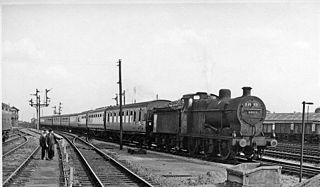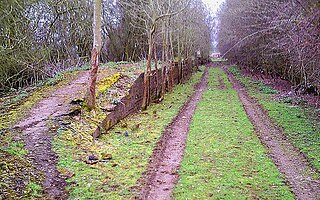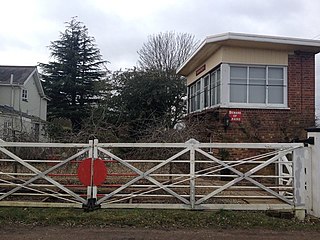
Rugby railway station serves the market town of Rugby in Warwickshire, England. The current station dates from 1885; two previous stations dating from 1838 and 1840 respectively, existed at locations to the west of the current one. It has been Rugby's only station, since the closure of the former Rugby Central station in 1969, on the now-abandoned Great Central Main Line route through the town. Between 1950 and 1970, the station was known as Rugby Midland before reverting to its original title. The station underwent an extensive remodelling between 2006 and 2008; new platforms were added and a new ticket office and entrance building were constructed. The original Victorian part of the station was retained in the upgrade.

Market Harborough railway station is a Grade II listed station which serves the town of Market Harborough in Leicestershire, England. It is situated to the east of the town centre and lies on the Midland Main Line, 16 miles (26 km) south-east of Leicester.

Stamford railway station serves the town of Stamford in Lincolnshire, England, and is located in St Martin's. The station is 12.5 miles (20 km) west of Peterborough. It was opened by the Syston and Peterborough Railway, part of the present day Birmingham to Peterborough Line. CrossCountry operate the majority of services as part of their Birmingham to Stansted Airport route. It is owned by Network Rail and managed by East Midlands Railway

Melton Mowbray railway station serves the market town of Melton Mowbray in Leicestershire, England. It is owned by Network Rail and operated by East Midlands Railway, though CrossCountry operates most of the services as part of its Birmingham New Street to Stansted Airport route. The station is on the route of the Syston and Peterborough Railway, which is now part of the Birmingham to Peterborough Line. It has a ticket office, which is staffed part-time, a car park, and help points for times when no staff are present.

Peterborough East was a railway station in Peterborough, England. It was opened on 2 June 1845 and closed to passenger traffic on 6 June 1966. Located on East Station Road just off Town Bridge, only the engine sheds and one platform remain. The station had services running west to Northampton and Rugby, as well as to the east to March, Wisbech, and Norwich.

Wansford railway station is the headquarters of the Nene Valley Railway in Cambridgeshire, England. The station building was opened in 1995 and contains a ticket office, shop, cafe and toilets. The locomotive sheds are located at this station. Also at the station there is a picnic area and children's playground. The station was formerly the junction for a branch to Stamford, which separated to the north just east of the river bridge at Wansford.

Luffenham railway station is a former station of the Syston and Peterborough Railway serving the villages of North and South Luffenham, Rutland.

Ketton and Collyweston railway station is a former station serving the villages of Ketton, Geeston, Aldgate and Collyweston, Rutland. It is located in Geeston adjacent to a level crossing on the Ketton to Collyweston road. It is under half a mile from Ketton but over a mile from Collyweston. It closed in 1966.

Morcott railway station is a former station in Rutland, near the village of Morcott.

Seaton railway station was a station serving the villages of Seaton, Rutland, and Harringworth, Northamptonshire.
The Great Northern and London and North Western Joint Railway was a British railway line, almost entirely within Leicestershire. Authorised by the same Act of Parliament, the Great Northern Railway Leicester Branch was built, branching from the Joint Line; on the same basis the Newark to Bottesford Line was built. The lines opened progressively between 1879 and 1883. The dominant traffic was iron ore, and the agricultural produce of the area served also generated considerable business. The passenger usage was never heavy, although some unusual through services were attempted at first.

The Northampton–Market Harborough line is a closed railway line in England. It opened on 16 February 1859 and finally closed on 16 August 1981. The former trackbed is used by the Brampton Valley Way and part of the route has been re-opened as the Northampton & Lamport Railway.
The Northampton and Peterborough Railway was an early railway promoted by the London and Birmingham Railway (L&BR) to run from a junction at Blisworth on the L&BR main line to Northampton and Peterborough, in England. The construction of the line was authorised by Parliament in 1843 and the 47 mile line opened in 1845. The line largely followed the river Nene, and for the economy of construction, it had many level crossings with intersecting roads, rather than bridges. In 1846 the L&BR joined with other companies, together forming the London and North Western Railway (LNWR).

Clifton Mill railway station was a railway station serving Clifton-upon-Dunsmore in the English county of Warwickshire. It was opened on the Rugby and Stamford Railway in 1864.

Lilbourne railway station was a railway station serving Lilbourne and nearby Catthorpe in Leicestershire, England. It was on the Rugby and Stamford Railway between Clifton Mill and Yelvertoft and Stanford Park.

Yelvertoft and Stanford Park railway station was a railway station serving the villages of Stanford-on-Avon and Yelvertoft in the English county of Northamptonshire and the stately home of Stanford Hall nearby in Leicestershire. It was opened as Stanford Hall on the Rugby and Stamford Railway in 1850.

Welford and Kilworth railway station was a railway station serving Welford and North and South Kilworth in the English county of Leicestershire. It was opened as Welford on the Rugby and Stamford Railway in 1850.

Theddingworth railway station was a railway station serving Theddingworth in the English county of Leicestershire. It was opened on the Rugby and Stamford Railway in 1850.
Lubenham railway station was a railway station serving Lubenham in the English county of Leicestershire. It was opened on the Rugby and Stamford Railway in 1850.
The Syston and Peterborough Railway was an early railway in England opened between 1846 and 1848 to form a connection from the Midland Counties Railway near Leicester to Peterborough, giving access to East Anglia over the Eastern Counties Railway. The project was part of the ambition of George Hudson to establish and maintain a monopoly of railway service over a large area of England. The surveying of the line achieved notoriety when Robert Sherard, 6th Earl of Harborough, who was hostile to railways, arranged a battle to obstruct surveys of the proposed line, and later of its construction.
















